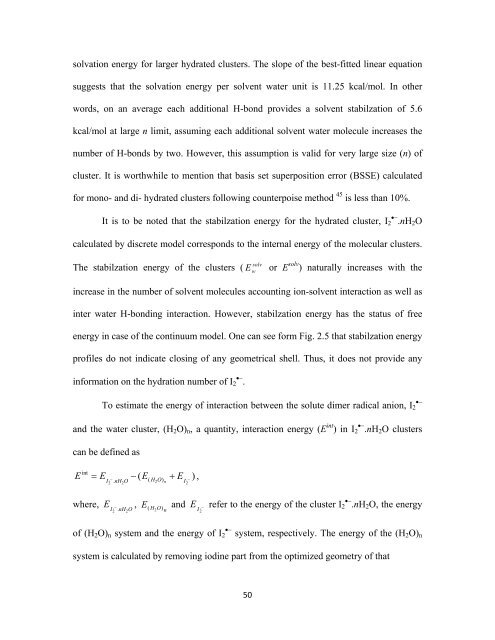CHEM01200604005 A. K. Pathak - Homi Bhabha National Institute
CHEM01200604005 A. K. Pathak - Homi Bhabha National Institute
CHEM01200604005 A. K. Pathak - Homi Bhabha National Institute
You also want an ePaper? Increase the reach of your titles
YUMPU automatically turns print PDFs into web optimized ePapers that Google loves.
solvation energy for larger hydrated clusters. The slope of the best-fitted linear equation<br />
suggests that the solvation energy per solvent water unit is 11.25 kcal/mol. In other<br />
words, on an average each additional H-bond provides a solvent stabilzation of 5.6<br />
kcal/mol at large n limit, assuming each additional solvent water molecule increases the<br />
number of H-bonds by two. However, this assumption is valid for very large size (n) of<br />
cluster. It is worthwhile to mention that basis set superposition error (BSSE) calculated<br />
for mono- and di- hydrated clusters following counterpoise method 45 is less than 10%.<br />
It is to be noted that the stabilzation energy for the hydrated cluster, I •− 2 .nH 2 O<br />
calculated by discrete model corresponds to the internal energy of the molecular clusters.<br />
The stabilzation energy of the clusters ( E w<br />
solv<br />
or E solv ) naturally increases with the<br />
increase in the number of solvent molecules accounting ion-solvent interaction as well as<br />
inter water H-bonding interaction. However, stabilzation energy has the status of free<br />
energy in case of the continuum model. One can see form Fig. 2.5 that stabilzation energy<br />
profiles do not indicate closing of any geometrical shell. Thus, it does not provide any<br />
information on the hydration number of I 2 •− .<br />
To estimate the energy of interaction between the solute dimer radical anion, I 2<br />
•−<br />
and the water cluster, (H 2 O) n , a quantity, interaction energy (E int ) in I 2 •− .nH 2 O clusters<br />
can be defined as<br />
int<br />
E = E − ( E + E ),<br />
where, E I<br />
−<br />
I . nH O ( HO)<br />
n I<br />
. . −<br />
2 2 2 2<br />
. −<br />
2 2<br />
. nH O<br />
, E( HOn 2 )<br />
and E I<br />
.− refer to the energy of the cluster I •− 2 .nH 2 O, the energy<br />
2<br />
of (H 2 O) n system and the energy of I 2 •− system, respectively. The energy of the (H 2 O) n<br />
system is calculated by removing iodine part from the optimized geometry of that<br />
50
















